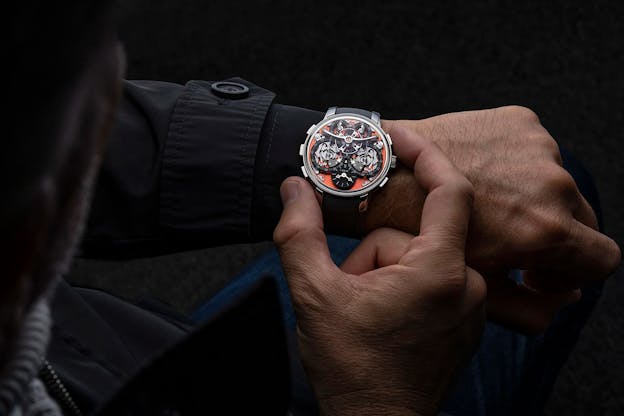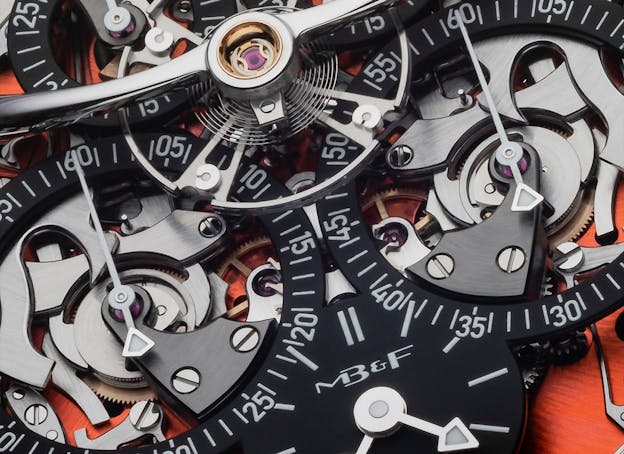Introducing The MB&F Legacy Machine Sequential Flyback
Stephen Mcdonnell has finally designed the version of the Sequential EVO chronograph he’d intended to make from the beginning.
Back in 2020, MB&F introduced one of the most exciting new chronographs any maker had produced in many years. That was the Legacy Machine Sequential EVO. The Sequential featured a double train, single escapement movement with two separate vertical clutch chronographs – in the Sequential, the chronograph seconds are in subdials at 3:00 and 9:00, with two 30 minute subdials at 11:00 and 1:00. Operation of the two chronographs is via start, stop, and reset pushers for each separate chronograph train.

There are a number of innovative and ingenious features in the Sequential EVO, but two are especially noteworthy. The first of these are the vertical clutches themselves. 
In this picture, everything you see outlined in red is turning as long as the watch is running, including the large upper wheel which is the movement fourth wheel. The vertical clutch is on top and at the very top of the whole assembly is the return to zero heart cam. Above the heart cam is the pivot for the actual seconds hand, and you can see the upper side of the entire assembly through the open dial of the watch.

That pivot is actually a long shaft that extends down through the hollow center of the long pinion extending from the underside of the vertical clutch to the lower wheel. When the chronograph starts, the vertical clutch drops into position on the fourth wheel and the internal shaft begins to turn. The lower intermediate wheel begins to turn as well, and this is the wheel that drives the minute counters. This internally jeweled vertical clutch was developed so that the chronograph trains would be directly in the power flow from the two mainspring barrels, eliminating potential flutter from the movement of the seconds hands, and also doing away with the need for the friction-inducing tension spring found in many chronographs, which is used to stabilize the movement of the seconds hand (again, remembering that the chronograph train in most chronographs is indirectly powered by the going train).
The second feature is the Twinverter system. This is a switching mechanism that can be used to “invert” the functions of each of the two chronograph trains. The Twinverter button is located on the left side of the case, at 9:00. It is essentially a secondary system for operating the two column wheels. It’s pretty straightforward. If neither chronograph is running, pushing the Twinverter will start both chronographs. If both chronographs are running, it will stop both chronographs. Finally, if one chronograph is running and the other is not, pushing the Twinverter will start the chrono that isn’t running, and stop the one that is. This system can be used for a number of different timing scenarios, many of which will occur to the imaginative enthusiast – you can even use it as a kind of chess clock.
The new version of the Sequential adds a flyback function to what was already a highly complex chronograph mechanism.

Each of the two chronograph trains is equipped with a flyback function, operated by the two reset buttons; if a reset button is pushed while the chronograph is running, the seconds and minute counters will “fly back” to the zero position and begin running again immediately once pressure is released from the reset button. The flyback chronograph expands what was already a number of possible uses (including using the watch as a chess clock; it also improves on the conventional rattrapante, where you are usually limited to split times of 60 seconds unless you happen to be the proud owner of a Lange Double Split).
MB&F says that the original concept for the Sequential EVO included a flyback system on the left hand chronograph, but by the time the Sequential EVO was ready to launch it was clear to Stephen Mcdonnell that additional prototyping would be necessary in order to ensure that the mechanism would run reliably. A major breakthrough in ensuring friction in the flyback system was kept to a minimum was the development of a specially shaped anti-friction ruby roller, which allows the system to function without a risk of accidental stoppage. The roller itself is of course a non-standard part – there is no such thing as an off-the-shelf anti-friction roller for a Sequential Flyback Chronograph – so Mcdonnell made the roller for the first prototype himself.

The back of the Sequential Flyback shares most of the construction features in the original Sequential EVO. These include the two vertically aligned mainspring barrels, and the two very conspicuous, large diameter titanium wheels which drive the chronograph minute counters.
One of the most important functions for flyback chronographs historically has been in air navigation (or “avigation,” as it was termed during the development of modern, precise celestial aerial navigation). When flying a pre-planned route, divided into several legs, it’s important to maintain a specific course and speed for a very specific interval of time; course changes are marked by restarting the chronograph. A flyback chronograph lets you stop and restart timing more or less instantly, which is especially valuable for aircraft, for which a delay of even a few seconds can put you off course (the more so if restart delays accumulate over a multi-leg flight plan).
This heritage influenced the redesign of the Sequential from the EVO to the Flyback model.

Although the Sequential EVO is as beautifully finished as you would expect from a Legacy Machine, it’s also got a slightly technical feel thanks to the design of the various subdials. The Sequential Flyback has a light sky blue dial, and the subdial rings are executed in white lacquer. Another change made was in the design and position of the subdial for the hours and minutes, which was flat in the Sequential EVO, but which has been inclined slightly towards the viewer in the Sequential Flyback (reminiscent of the inclined dials found in some other Legacy Machine models, like the Thunderdome). This further emphasizes the multi-layered architecture of the mechanism, which includes MB&F’s signature “flying balance” sitting under an arch of polished steel, above the level of the rest of the movement.

The overall effect is of a watch which, the aviation heritage of the flyback chronograph notwithstanding, feels somewhat more formal than its predecessor. The platinum case, at 44mm x 18.2mm, is imposing in size but as is the case with many MB&F watches, the size is appropriate to and even intrinsic to the movement itself.

As with the original Sequential EVO, the Sequential Flyback is both a technically advanced chronograph, and something of a mechanical meditation on what a chronograph means in terms of how we experience time, and especially the intervals of time which make up the structure of our experience of daily life. A basic watch depicts the passage of time as flowing smoothly and inexorably forward. The Sequential Flyback speaks more directly to the fact that while we do experience time as moving smoothly forward, we also experience it as a series of acuumulated and often, overlapping experiences – the relationships between which really establish the syntax and rhythms of our experience of everyday life.
The MB&F Sequential Flyback Chronograph: case, platinum, 44mm x 18.2mm, 88 components total, water resistance 30 meters; screw down crown with five pushers for the chronograph functions (including the Twinverter). Movement, fully integrated dual flyback chronograph with Twinverter, hand-wound with two mainspring barrels providing 72 hours of power reserve; “flying” balance wheel with Breguet overcoil; power reserve on the back of the movement. Finishing: internal bevel angles; polished bevels; Geneva stripes; steelwork beveled and straight grained or black polished; balance frequency, 21,600 vph running in 63 jewels. Limited edition of 33 watches total worldwide; price, $218,000. For more info (and a full list of Friends who made the watch happen) visit MBandF.com.

